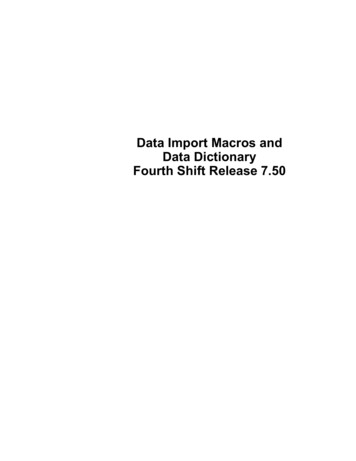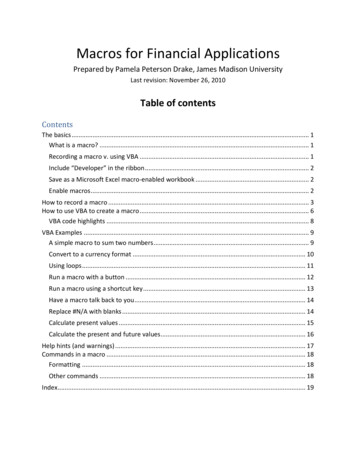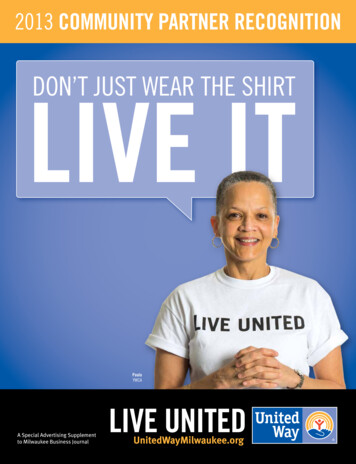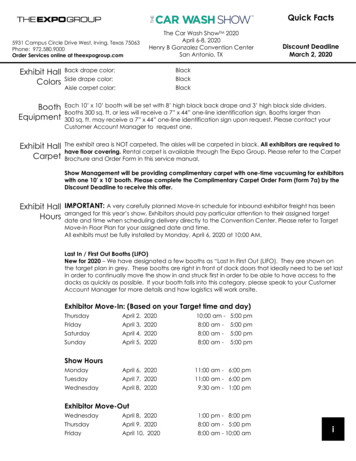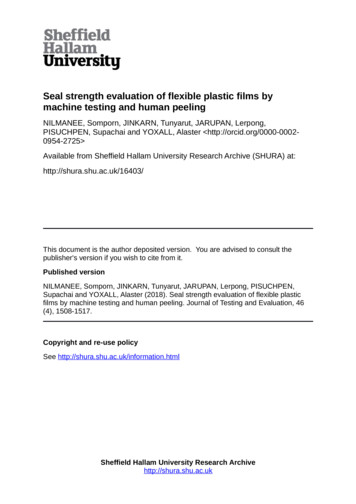
Transcription
EAT FANTASTICThe Macros Inc. Guide to Flexible Dieting
Copyright 2019 Macros Inc.All rights reserved. No part of this book may be reproduced or used in any mannerwithout written permission of the copyright owner except for the use of quotationsin a book review. For more information, contact: contact@macrosinc.netFirst EditionPublished by Macros Inc.macrosinc.net
1: Macros 101What Are Calories?. 5What Are Macros?. 6Protein. 6Carbohydrates. 6Fats. 72: Calculating MacrosCalculating Macros. 93: Weighing & Measuring FoodsWeighing Food. 12Measuring Liquids (Weight Vs Volume). 13Weighing Dry Goods. 13Weighing Meat. 144: TrackingTracking Recipes & Large Batches Of Foods. 16Logging Food Into My Macros . 17Finding Foods. 18Setting The Serving Size & Number Of Servings. 20Count Total Carbs, Not Net Carbs. 20Tracking Restaurant Food. 215: Meal PlanningPre-Planning Your Day In My Macros . 23Food Quality. 24Artificial Sweeteners. 24Water Intake. 256: Tracking ProgressTracking Progress. 27Stalls In Progress. 28macrosinc.net
1: Macros 101What Are Calories.5What Are t
What Are Calories?A calorie is a unit of energy. The calorie content of a food describes howmuch energy your body can get from consuming it. Though there are otherfactors involved, weight loss or gain ultimately comes down to how manycalories you consume. When you eat more calories than your body canuse, the extra energy is stored as body fat. When you need more energythan you are getting from what you eat, your body burns body fat for fuel.“Calories are typically written a kcal, Cal, or Calories (with a capital C). This is becausecalories as we see them listed in food products are actually kilocalories - 1,000’s of calories.In order to prevent a lot of zeros on your food labels, kcal or Cal is commonly used.”macrosinc.net page 5
What Are Macros?All foods are made up of one or a combinationof three macronutrients, or macros: protein,carbohydrates, and fat. The macronutrientcontent of a food determines its caloric value.Carbohydrates and protein both have 4 caloriesper gram, and fat contains 9 calories per gram.Calories don’t exist outside of these macros(excluding alcohol, which contains 7 caloriesper gram). Each macro has a different use inyour body. By tracking how much of each youconsume, you can impact many things such asbody composition (fat vs muscle mass), energylevel, and even your mood. No single macro isresponsible for fat gain or loss (you gain fat byeating more calories than you burn).ProteinProtein is found in nearly all of the tissues inour bodies, and consuming adequate protein isessential for life. Consuming the right amountfor your activity level and body compositiongoal is vital for achieving the physique youwant. Amino acids are the building blocks ofprotein. There are 20 different amino acids,and of these 20, your body can manufactureall but 9 of them on its own (these 9 are calledessential amino acids, because it is essential toget them from your diet). Some protein sourcesare more complete than others, meaning theyhave more or all of the 9 essential amino acidsthat your body can’t make itself. Every proteinsource you eat doesn’t need to be complete,but you want to make sure the combination ofproteins you are eating covers all of the aminoacids your body needs for adequate musclerepair and growth.macrosinc.netSome examples of complete proteins are: Meat Fish Eggs Dairy (including whey protein) Spirulina QuinoaSome examples of foods containingincomplete proteins are: Vegetables Seeds and Nuts Legumes GrainsCarbohydratesWhile carbs are not essential (meaning humanscan function without them), they are useful asa source of energy for the body. Many carbsources such as fruits and vegetables tend tobe very nutrient dense (containing vitaminsand minerals), and some contain dietary fiber,both of which are important for optimal health.Adequate fiber intake is important for digestionand gut health.Examples of foods that are primarilycarbohydrates include: Fruit and Vegetables Grains Potatoes Rice and Pasta page 6
FatsUnlike carbs, fats are essential—meaning thebody can’t function without adequate fattyacid intake. It’s important to point out thatconsuming dietary fat doesn’t contribute tofat gain unless total calories are in a surplus.Adequate intake of dietary fats is important forproper hormone function, proper absorption ofcertain vitamins, the production of cholesterol(vital for health), and also as a source ofenergy for certain activities such as distancerunning and other low to medium intensitycardiovascular activities.There are several types of dietary fat, includingtrans, saturated, monounsaturated andpolyunsaturated (includes omega-3 and 6).Trans fats are harmful and generally should becompletely avoided. Saturated fats may havesome negative health effects if consumedin excess, but they need not be completedavoided and even have benefits such as theproduction of testosterone. Polyunsaturatedfats are essential for life and health, andmonounsaturated fats have health benefitsas well.macrosinc.netExamples of trans fats (avoid): Hydrogenated and partiallyhydrogenated vegetable oil Shortening Some margarinesExamples of saturated fats (fine inmoderation): Coconut oil/Palm oil Animal fats (from meat) ButterExamples of polyunsaturated fats (essential): Fish oil Nuts/Seeds Some plant based oils such as sunflower oilExamples of monounsaturated fats: Avocado/Avocado oil Grapeseed oil Olive oil page 7
2. Calculating MacrosCalculating Macros.9macrosinc.net
Calculating MacrosWhile there is no single “correct”set of macronutrients for any givenindividual, there is a range of eachmacronutrient that is optimal for aparticular goal. We offer an easyto use calculator that will give youappropriate macros for your personalstats, preferences and goal.Click here to access the Macros Inc.macro calculatorEven though the calculator linked abovewill do the math for you, there is value inunderstanding how macros are calculated.First, appropriate calories are calculated.Generally speaking, 10-12x your bodyweightin pounds is an appropriate range for caloriesto lose weight, 13-15x body weight is wheremost would maintain, and 16x or greater is forgaining weight/muscle. Less active individualswould be towards the lower end, and moreactive towards the higher end of those valuesor higher. Very overweight/obese individualswill likely be even lower than the statedranges.For optimal body composition, adequateprotein is required. The amount needed forthis (retaining and/or building muscle) is muchhigher than the minimum amount neededfor basic health and avoiding deficiency. Thegenerally agreed upon amount for proteinintake for improving body composition isa range, from .8g-1.5g per lb of total bodyweight. Less is needed in a calorie surplus,while more is needed (for muscle retention) ina calorie deficit.macrosinc.net”I love that thecommunicationchannels are the sameones that I use everyday with friends.I reach out to my coach throughWhatsapp, just as often and easilyas I talk to friends. If I go quiet hechecks in with me. There is nopreplanned week plan or steps weneed to follow - coaching followsmy life and my need and hurdles,as they come up.”-Gila, Macros Inc. Member page 9
There is a minimum amount of dietary fatneeded for optimal health, but there isn’tenough research in this area for an absoluteamount to be known. Most experts agreethat a bare minimum amount of dietary fatis around .25-.3g per lb of body weight, or15-20% of your total calories. More fat in yourdiet is based on preference. Remember thatthe more fat you choose to have in your diet,the fewer carbs you can then have within yourcalorie allotment.It is important that your diet contains enoughcarbs to fuel your activity level. Sedentaryindividuals need fewer carbs, while thoseexercising hard need more. When carbs aretoo low, you may feel tired and sluggish, andexercise/athletic performance will suffer. Thistranslates to fewer calories burned and lessstimulus to muscles during workouts, whichcan be counterproductive to weight loss goals.Fiber is a subset of carbs, and it’s importantto get an adequate amount for optimaldigestive health. Fibrous foods also help withsatiety, keeping you feeling full. The Academyof Nutrition and Dietetics recommendsapproximately 14 grams of fiber for every 1000calories consumed. Sugar is another subsetof carbs and doesn’t need to be trackedseparately.The Macros Inc. Facebook group is a greatplace to go for additional information onmacros, support and ideas.Click here to access the group pageNow that you have an understanding ofwhat tracking macros is all about and how tocalculate them, you’ll now need to understandhow to accurately track them.In summary, tracking macros rather than justcalories has several benefits. Keeping proteinhigh enough ensures that you will retain asmuch lean mass as possible during a dietingphase, and that you will adequately repair andbuild muscle in a gaining phase. Adequatelevels of dietary fats is important for generalhealth. Eating the right amount of carbs allowsyou to maximize efforts in the gym, and keepsyou feeling energized. So while it is yourcalorie amount that ultimately determineswhether you will gain, lose, or maintainyour weight, tracking macros allows you tomaximize your results.macrosinc.net page 10
3. Weighing & Measuring FoodsWeighing Food.12Measuring Liquids (Weight Vs Volume).13Weighing Dry Goods.13Weighing Meat.14macrosinc.net
Weighing FoodWhen starting to track macros, one thing youmust have for the best chance at success is afood scale. Without weighing, it is impossibleto really know how much of a given food youare eating. People are notoriously bad ateyeballing or estimating how much food theyare consuming. Even measuring foods withcups can be very inaccurate, because thereis so much variability with how tightly packedand how full one might fill the measuring cup.The good news is that you can find a goodfood scale for 15- 25. Amazon, Target andWalmart are good places to find them. Lookfor a digital scale that measures in grams(grams are a smaller unit of measurement thanounces, and so it is a more precise way ofweighing).and calorie content of that amount of food foryou. If you don’t want to use an app, you canuse something like an Excel spreadsheet, oreven just pen and paper.Even packaged foods need to be weighedfor 100% accuracy. For example, the labelon your loaf of bread might state that oneslice of bread is 30g. You weigh yours, andits actually 41g. If you would have logged itas 1 slice without weighing, you would havebeen underestimating how much you ate.It might seem like a tiny detail, but thoseslight differences happening with everythingyou eat, day after day can add up to a largediscrepancy between what you log andwhat you actually consume. This can make itfrustrating when progress isn’t happening, andyou feel you are “doing everything right”.The basic idea is that you weigh the food itemso that you know the quantity you are eating.Then, you use a calorie/macro tracking applike My Macros to log the amount you ate ofeach food. The app then counts the macrosmacrosinc.net page 12
Measuring Liquids(Weight Vs Volume)A substance’s weight is a measurement of itsmass, while volume is a measure of how muchspace the substance takes up. Grams, ounces,pounds, tons are units of weight/mass. Fluidounces (not the same as ounces!), milliliters,tablespoons, cups, gallons are units of volume.In general, solid items should be weighed, andliquids should be measured. While some scalesdo have a fluid ounce and/or milliliter setting,mass only equals volume when measuringwater (1 oz 1 fl oz), so it will be inaccurateto weigh liquids other than water even usingfl oz or ml settings on a scale. Use measuringspoons and cups for liquids.macrosinc.netWeighing Dry GoodsPackaged foods all have nutrition labels, andthe nutritional information/macros on thatlabel is always for how the food comes toyou in the package. Food manufacturers payto have a lab analyze the nutritional contentof the food in the state that it is sold to you.Therefore, the weight stated on the label ofdry goods like pasta, rice, oats, grains etc., isfor the uncooked product. You should weighthese items dry in order to have the macros onthe package be accurate. page 13
Weighing MeatMeat is most accurately weighed and loggedin its uncooked state. When you cook meat,water (and a small amount of fat) is cookedoff, but the amount will vary depending onthe method of cooking (baking vs crockpotvs a skillet etc.), and to what temperature youcook the meat. A rare steak will retain morewater than a well done steak, for example,yet both are technically “cooked”. The USDAhas a database of essentially every cut ofmeat, fish and poultry and the raw macros foreach. When you purchase meat at the storeand there is a label on it, that label is for theraw product. So to use those macros whentracking, you must weigh it raw.The USDA database also has cooked macrosfor most cuts of meat and fish. You can usethese if you feel it is more convenient to weighyour meat after cooking, but remember thatit will not be as accurate as raw because yourmethod of cooking and level of doneness mayvary from what was done to the cooked meattested by the lab. Some meat products, suchas bacon, specify that the macros on the labelare for the cooked product, so of course youshould weigh it cooked.Whether you weigh raw or cooked, the mostimportant thing is consistency. Try and do itthe same way, every time for best results andto limit the variability in your tracking.macrosinc.netClick here to access the USDA NutrientDatabase for nutritional infomation onmeat and produce page 14
4. TrackingTracking Recipes & Large Batches Of Foods.16Logging Food Into My Macros .17Finding Foods.18Setting The Serving Size & Number Of Servings.20Count Total Carbs, Not Net Carbs.20Tracking Restaurant Food.21macrosinc.net
Tracking Recipes& Large Batches of FoodsVery few people only ever cook for themselves insingle-serve amounts. Therefore, it is importantto know how to accurately track food when youcook it in large batches, or when you have lots ofingredients mixed together in a recipe.For recipes:There is a recipe builder function as part ofmost calorie/macro tracking apps. It’s easiestto use this function for recipe tracking. Weigh all ingredients dry/raw as you addthem to the recipe, logging them in thecorrect quantity to the recipe in yourtracking app. The recipe function might ask you to enterhow many servings up front – put in anarbitrary number of servings as you will editthis after cooking. Cook the food. After cooking, you want to weigh thefinal product. Edit your recipe and change number ofservings to the weight in grams of your finalproduct (minus the weight of the containerif applicable). For example: if you madechili, and it weighs 3456g (not includingthe container weight) you would edit yourrecipe to state it is for 3456 servings. To log what you eat, weigh out whateverportion you want to eat and log thatamount as the number of servings. Forexample: if you dish up 345g of your chiliinto a bowl, log as 345 servings of yourrecipe. Essentially, 1g 1 serving whendone this way.macrosinc.netFor batch cooking of dry goods or meat: Weigh the total amount of meat ordry goods uncooked. Cook it. After cooking, weigh the total amount ofcooked food. Determine how many servings you want thefood to make, and divide the total cookedweight by that number. For example ifyou want 600g of cooked rice to be 6equal servings, divide the rice into 6 100gservings. Then log as that same fraction of the rawweight. Continuing the 600g cooked riceexample – if you ate 100g of cooked rice,that was 1/6 of the total 600g of cookedrice. If the total dry weight of the rice was200g, you ate 1/6 of 200g or 33.3g of dryrice (200 divided by 6). You would log as33.3g dry rice if you ate 200g of cookedrice in this example. page 16
Logging Food into My Macros There are many different tracking appsand methods as previously mentioned.My Macros (often referred to asMM ) is our recommended app dueto ease of use, and so it is what we arerecommending and giving instruction onusing in this document.The first thing to note is that MM should beused to track your food intake and macros.Calculate your macronutrient goals using ourcalculator linked here, and then use the app totrack your eating to hit those macros.macrosinc.netMM is a one time purchase ( 2.99 USD)which unlocks all of the features needed totrack your macros. There is also a Pro versionof MM for 1.99 (USD) per month. Thisunlocks the desktop/web based option as wellas additional charting/graphing features.My Macros can be downloaded inyour mobile device’s app store or atgetmymacros.com page 17
Finding FoodsTo log what you eat (using the app), click themenu icon in the top left of the screen to go tothe “Food Menu” and then tap “Search”.You will also want to make sure that globalsearch is on, this way, you will have a largerdatabase to search. Click the gear icon on thetop right & enable “Global Search”.”At 400 lbs, I was at the end of my rope.I didn’t know what to do or whereto go. I started doing researchand reaching out to friends. Factis, I thought I knew everythingabout dieting. Turns out, I knewall the things that were wrong,to know about dieting. Learninghow energy balance reallydictates fat loss, that hours ofendless cardio in the gym weren’tnecessary for success helped meto focus on what counted (for me)which was my diet.”Beforemacrosinc.netAfter-Gabe, Macros Inc. Member page 18
You can search for a food by typing in thesearch bar or you can click the “BarcodeScanner” option in the Food (for packagedfoods with a bar code). Please note that allentries, even barcode scanned entries, areuser-entered and therefore may be incorrect.Always compare what you find to the macroson the package of your food, or to the USDAnutrient database. If there is a discrepancy,assume the MM entry is wrong and thepackage/USDA database is correct.Editing any entry (barcode or database item) isvery simple. Tap the pencil icon & then “EditFood Info” from the menu that appears.If you come across a food that cannot befound, or if you can’t find an accurate entry fora food you can create your own entry. Fromthe Food Menu, tap the sign on the top rightand you will be able to enter a custom item.The entry will then be stored in your personaldatabase for future use.”My progress has gone above andbeyond weight loss and inches lost.For me it is so much more than that. Going into this Ithought it was only going to be about weight loss andthe scale, but I was so wrong. This is about me as awhole person, making me a better version of myselfboth physically and mentally.”-Courtney, Macros Inc. Membermacrosinc.net page 19
Setting the Serving Size& Number of ServingsAs previously stated, you need to weigh (ormeasure if liquid) what you are eating in orderto know how much to log. You will find thatsome entries do not have grams as an optionfor serving size, while others do. You canalso filter your search results by serving sizein MM . You can always create a new foodentry (or edit an existing one) and use gramsas the serving size when you can’t find anaccurate existing entry in grams. Enter the unitof measure you’re consuming as the ServingName (ex: gram) and then how many of thatsize as the Serving Size (ex: 30 if 30g – you arehaving 30 1g servings).When looking at the app to determine howmuch you have eaten or have left to eat, thereare two places you can check. The top andbottom of your Meals screen.The top numbers will display remaining macrosand calories. The lower numbers display bothconsumed and remaining macros/calories.Simply tap one of the numbers to switchbetween consumed and remaining.The goal is to hit each macro within 5g.Calories are what determine loss or gain, andhitting macros exactly right hitting calories. Ifyou go over on one macro, you’ll have to stayunder on another so that you don’t go overcalories. 1 carb or protein gram is 2.25g offat (the reverse being that 1 fat gram 2.25gor carbs or protein). So for example, if youwent over your fat goal by 11g, you’d need tostay under carbs by 22.5g. (You would NOTtake away from protein, because protein isessential while carbs are not).macrosinc.netCount Total Carbs,Not Net CarbsMake sure you are counting TOTAL carbs andnot Net Carbs (net carbs is when the fibercarbs are subtracted out of the carb count andnot counted in the calories for the item).We count all carbs (including fiber and sugar)towards carb grams. Check your entries andmake sure you are logging foods with all carbslisted and the calories of the item reflectingthe total carb count. Common culprits for netcarbs being listed are fiber supplements/bars,Atkins brand and other low-carb marketedproducts (like Quest bars). page 20
Tracking Restaurant FoodEating out is a part of a healthy social life, and it shouldn’t be avoided justbecause you are dieting. It can get tricky because only large chains tend to havenutrition information available for their menu items, and it is hard to know how toestimate when you don’t know what went into the food you are eating.Some tips for eating out include: Order items with only a few ingredients, like a protein with a carband/or veggie as sides. This is easier to visually quantify and log, ascompared to pastas, cassroles, soups etc., that have many ingredients inquantities you can’t easily guess. Order sauces and dressings on the side so that you can see and controlthe amount used. Find a similar item that is in My Macros if your restaurant doesn’tprovide info, and log that. It will not be exact, but is an estimationat least. If possible, decide what you will have and log your meal out at the startof the day, planning your other meals around it.Limit meals out to 2-3 per week for best results, just because they are so difficult to accurately track.macrosinc.net page 21
5: Meal PlanningPre-Planning Your Day In My Macros .23Food Quality.24Artificial Sweeteners.24Water Intake.25macrosinc.net
Pre-Planning YourDay in My Macros If you are new to counting macros,you will likely find it difficult at firstto figure out the right foods to eatin the right quantities to hit yourmacros. Instead of just eating whatyou think you should eat and thenlogging it afterwards, try pre-loggingyour food instead.In the morning, or even the night before, logthe foods you think you want to eat in thequantity you think you want to eat them andthen see where you are at with hitting yourmacros. You can then adjust portion sizes ofthe foods you logged, or swap out one foodfor another. Do this until you get within 5g oneach macro. Now you know exactly what toeat, and you won’t be stuck way over or underon any macro at the end of the day.”I have made TONS ofprogress with Macros Inc.Not beating myself up for everysmall mistake. What I expected wasa plain macros count and a trainingplan. What I got was a family anda coach who I can fall back on, nomatter how many times.”-Shareshtha, Macros Inc. Membermacrosinc.net page 23
Food QualityWhile weight gain or loss ultimately comesdown to calories in vs calories out, foodchoices still matter for things like generalhealth and satiety/ability to adhere to the diet.Sometimes, people associate IIFYM or macrocounting with “junk food”, but that should notbe how this way of eating is approached.The “80/20” RuleA commonly used phrase with flexible dietingis the “80/20” rule, meaning 80% of yourdiet should consist of whole, nutrient densefoods leaving 20% to be filled with more “fun”foods that you love but aren’t necessarilynutritious. The premise here is that once youhave fulfilled your body’s requirement formicronutrients and fiber, you can then eatwhatever else you want to fill your daily macrorequirements since you can’t “stock up on thegood stuff” by continuing to eat more onceyou’ve maxed out. This tends to go againstthe popular “clean eating” movement, whichtends to demonize all processed foods.Carb QualityAll of that being said, it is important torecognize that all carbs aren’t created equally.Some sources of carbohydrates contain a lotof sugar or other simple carbohydrate and notmuch else (treats like cookies, candy, soda,chips etc.). If you eat too much of these, you’llquickly max out your carb allotment withoutcoming close to fulfilling the vitamins, mineralsand fiber that you should have also consumed.So, going back to the 80/20 rule, the approachfor best health would be to get 80% of yourcarbs from sources rich in micronutrients andfiber (veggies, fruit, grains), leaving the 20%for those other carbs that basically justtaste great.macrosinc.netArtificial SweetenersUse of artificial sweeteners instead of sugaris one way to avoid extra carbohydrateconsumption. The question of whether artificialsweeteners and things like diet soda arebad for us is one that comes up frequentlyin dieting and health related circles. Studieshave not been able to prove that artificialsweeteners are indeed harmful in any dosethat a human could actually consume on adaily basis. There are correlational studiesthat often get quoted, but it is important torecognize that correlation doesn’t prove thatone thing caused another.While products containing artificial sweetenersmay not be inherently nutritious or beneficialby themselves, they can help contribute toweight loss and better health for some peopleif they are replacing higher calorie options. It isnot true that artificial sweeteners spike insulin,and they do not contribute to fat gain in anyway (since they are zero calorie, they can’t). page 24
Water IntakeContrary to what is often stated in many diet/fitness circles,all beverages containing water (with the exception of alcoholicbeverages) count towards a person’s daily water consumption.Your body breaks everything you consumedown into its “usable parts”, and so it is goingto use all of the H2O molecules that comein, whether they were pure water, in your Dr.Pepper, or even coffee when you drank them.(In regards to caffeine – it is true that it hasa mild diuretic effect, but this effect is notenough to offset the hydration effects of thewater contained in the beverage).
would be towards the lower end, and more active towards the higher end of those values or higher. Very overweight/obese individuals will likely be even lower than the stated ranges. For optimal body composition, adequate protein is required. The amount needed for this (retaining and/or build

